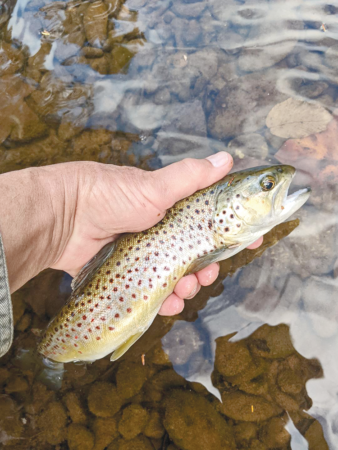I’m sure it comes as no surprise that I am an avid fisherman, and when it comes to catching trout, the flyrod is my first choice.
My number one presentation with the flyrod would be dry flies drifted into the path of a rising trout; there’s just something really exciting about setting that hook into the jaws of a rising trout and feeling that sudden bend in the rod.
If asked, I suspect that most fly fishermen would probably have the same response as I do — a dry fly presentation to a rising trout.
When trout season rolls around in April, and especially into May and June, the dry fly fishing really picks up with all kinds of flies hatching and trout often feeding heavily on the flies as they drift by. This period is one of the best for dry fly fishing with warming water and a variety of hatches.
As we move into the fall months, hatches diminish considerably, and often, the surface activity is now centered around terrestrials like ants, crickets, grasshoppers, and other land-based insects.
By November and into December, the last thing most fly fishermen are thinking about is making surface presentations; in fact, most fly fishing types have already hung up their flyrods for the winter.
I say all of this because Terry Wineberg, a fly-fishing buddy of mine, told me he picked up a pretty good number of trout while fishing dry flies in late October. With the warm weather and the lack of rain, the streams are actually in decent shape if you can locate some deep enough holes to fish.
It was November the fifth before I had a chance to get out and see for myself if I could produce some action on dry flies. I certainly wasn’t expecting much, but to my surprise, when I arrived at one of our local streams, I spotted a good number of fish taking something on the surface.
I couldn’t determine what they were taking, but I tied on an old, reliable Adams in a size 14 and started to pick up fish. I also succeeded with a 16 blue-winged olive, often produced throughout the summer months.
It was the first time I ever caught trout on dry flies in November, and it certainly wasn’t what I expected in early November. To be honest, my fishing buddies and I usually think about getting our ice-fishing gear together in November.
I’m sure the unusually warm weather this fall contributed to that fly fishing success. Also, a lack of rain kept the streams quite clear and low-flowing, helping to keep water temperatures up some and probably encouraging more active trout feeding.
If you had told me a couple of weeks ago that I would be taking trout on a dry fly in November, I would have had some serious doubts, but not anymore.
In the meantime, I think I’ll gather all my deer hunting gear and my ice-fishing gear.




